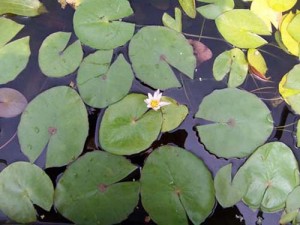 The beautiful water lilies that graced your pond with blooms this summer need special care this winter. They are tropical in origin and will not
The beautiful water lilies that graced your pond with blooms this summer need special care this winter. They are tropical in origin and will not
become dormant to survive our winters unless you live in Zones 9 or 10. There are several methods for over-wintering these plants. One will be just right for you!
The key to successful over-wintering is the following: It is extremely important not to place the water lily into the pond before Mother Nature
is ready for it. This means DO NOT place the plant into the pond before the water temperature is at least 70 degrees F even if the air temperature is high! Cold water will bring about the demise of the plant and negate your hard work and patience.
The simplest and most successful way to insure survival of these tropical plants is storage in a greenhouse. There they will over-winter nicely in a tub or other container. The object is just survival not plant growth, so container size is not crucial. Provide only 10% to 20% of the space that you
allotted to the plants in your pond. Do not fertilize them. Next year, when the minimum water temperatures reach 70 degrees F, it will be safe to repot and replace the water lilies into you pond.
Very small plants may be over-wintered in an aquarium. For this method, a viviparous lily (one that makes new plantlets at the leaf node) works best. The goal with this method is to keep your lily alive without too much growth.
The small new plantlet should be separated from the parent plant no later than the middle of October. Use a 4” or 6” plastic pot without drainage holes or plug the holes on the ones you already have. Pot the plantlet into it. Place the potted lily into a 20 gallon or larger aquarium. Place a fluorescent grow light over the top of the tank. This must be placed as close as possible to the tank top. The aquarium water will need to be kept warm with a heater. Water temperature should be 70 to 75 degrees. Too high temperatures will encourage too much plant growth and too low temperatures will result in an unthrifty plant for the spring season. When spring arrives and the water temperatures are 70 to 75 degrees, the plant may be potted into a 10 quart or larger container and set into the pond for you to enjoy.
Not everyone has access to a greenhouse or an aquarium, if this is a problem for you, another method is available. This technique is used by plant propagators. It will work because of the lifecycle of the tropical lily in its native habitat. Around the end of September which is the end of the growing season for lilies in our zone, skip the last fertilization. The plant will become stressed (hungry). This stress results in a tuber. Allow the plant to remain in the pond until all the leaves are dead. This is a process that may take several frosts to accomplish. Now search under the crown of the plant for a hard tuber. Successful storage of our lily depends on finding this hard tuber.
There may be a very large tuber about the size of a baseball or a very small one about the size of an acorn. There may also be several small tubers growing around the larger one. The smaller tubers are more likely to produce good plants next spring than the larger ones.
Let the tuber air-dry for a few days if it still has root or stem tissue attached to it. A callus will have formed to protect the tuber from dehydration. The debris will snap clean from the tuber. Wash the tuber and place it into a jar or plastic bag filled with distilled water and then store it in a cool, dark place. The temperature should be around 50 to 65 degrees F.
Check the container each month. If the water is discolored or foul smelling, replace it with fresh distilled water. If you used a hard tuber and took care to clean it properly, it should survive the winter.
